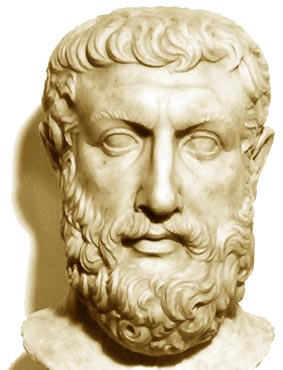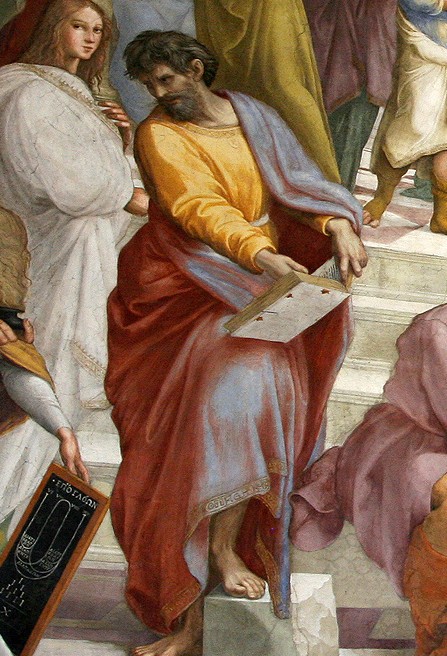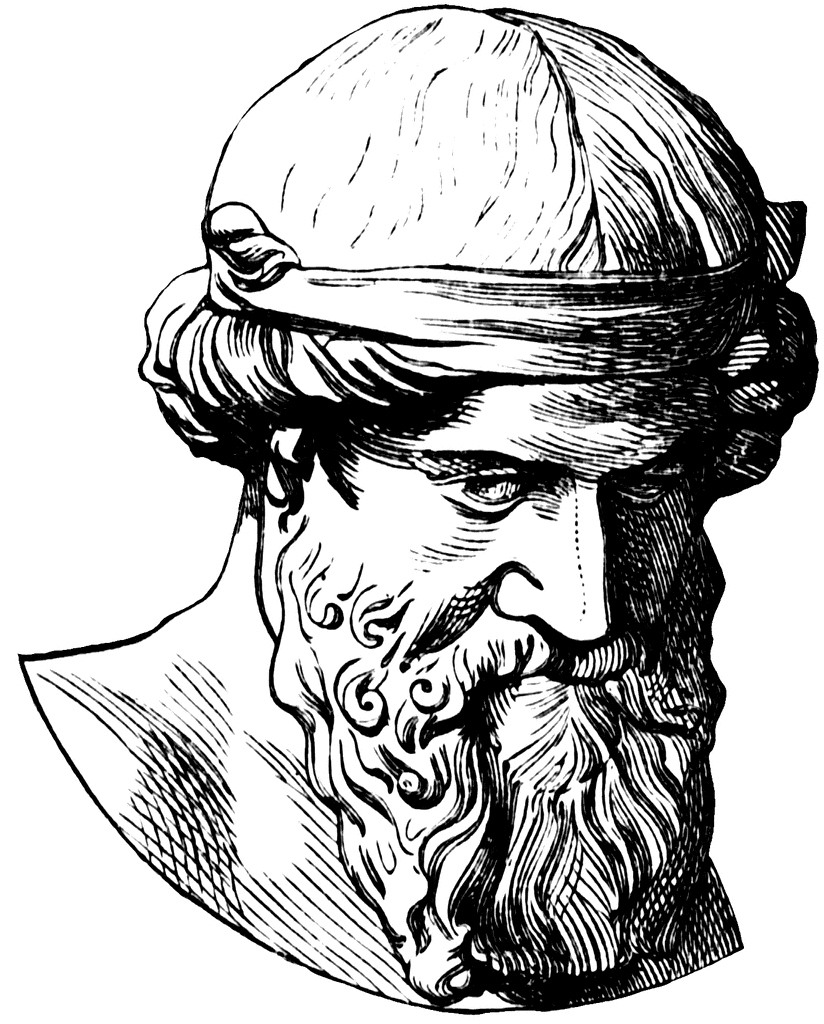By. Van Bryan
The Parmenides (also known as, “Oh God, please don’t make us read that thing” in most philosophy classes) is a rather complex and intricate text that pits a youthful Socrates against the old Elatic philosopher, Parmenides.
 The narrator is Cephalus, a man who later appears in Book I of The Republic. Cephalus tracks down Plato’s half-brother, Antiphon, who is said to have memorized a conversation between Zeno of Elea, Parmenides, and a twenty-year-old Socrates. The actual narration of the dialogue is so far removed from the active voice of Plato that it is likely that Plato himself may doubt the historical accuracy of the encounter.
The narrator is Cephalus, a man who later appears in Book I of The Republic. Cephalus tracks down Plato’s half-brother, Antiphon, who is said to have memorized a conversation between Zeno of Elea, Parmenides, and a twenty-year-old Socrates. The actual narration of the dialogue is so far removed from the active voice of Plato that it is likely that Plato himself may doubt the historical accuracy of the encounter.Keep in mind that the context of the dialogue, the characters and the story of how they meet are all just trimmings when compared to the meaty philosophical arguments. It is those philosophical dialectics that are of principle interest to us today. And boy let me tell you, they are something of a doozy.
The dialogue tends to focus on Plato’s infamous Theory of Forms. Specifically, the text looks to examine the relation that the forms have with sensible particulars and then begins a series of counter arguments against the Theory of Forms in general. The question naturally arises: why would Plato write a dialogue that gave such a thrashing to his own ideas?
The answer is far from certain. Perhaps Plato is accurately recounting the views of the Presocratic, Parmenides. Perhaps Plato has his own doubts about the forms. It is possible that with the spirit of healthy intellectual debate in mind, Plato is presenting a possible counter argument for the sake of expanding our knowledge.
Whatever the reason, or combination of reasons, there is one thing that we must keep in mind while examining The Parmenides. The notions of being, of oneness, of becoming, of the forms and their relation to the particulars that are discussed within the text, are not merely food for thought. They are not amusing intellectual acrobatics performed by the philosopher for the sake of kicks, with no real hope of concrete application.
Metaphysics, the study of being qua being, was of great importance to the Greek philosophers. The study ultimately aimed at answering the following questions:
1. What is ultimately there?
2. What is it like?
3. And how in the world did it get there?
 If we take for granted the notion of existence or the process of becoming, it is only because great minds like Plato were there thousands of years beforehand to shake out some sensible information from the unbridled chaos of the universe.
If we take for granted the notion of existence or the process of becoming, it is only because great minds like Plato were there thousands of years beforehand to shake out some sensible information from the unbridled chaos of the universe.So while reading The Parmenides, if you are brave enough to ever do that, keep in mind that the topics discussed would be on equal footing with the question and consequences of Gods existence or non-existence that are regularly considered by modern theologians.
With all that in mind, we press onward. I have often described philosophy as “those deep and dark waters.” I still think that that comparison is rather apt. So as we dive headlong into The Parmenides, keep in mind that these waters are some of the deepest and some of the darkest.
First, we must understand Plato’s Theory of Forms. Very briefly, the theory states that there is a single, eternal, indivisible, perfect, universal form that corresponds to any sensible thing within our universe. The function of these forms is to explain how things have the properties that they do.
For instance, there is a form of beauty; every sensible thing that we might consider beautiful is in some way related to this form. The same can be said for the form of justice, wisdom, goodness, etc. The question then becomes…
How is it that the forms and the particular, concrete objects interact?
 That’s a difficult question! It is so difficult, in fact, that a more practical person might just leave the discussion right there and go on to other, easier activities, like trying to count the number of blades of grass in your front yard.
That’s a difficult question! It is so difficult, in fact, that a more practical person might just leave the discussion right there and go on to other, easier activities, like trying to count the number of blades of grass in your front yard.However, we (you and me) are philosophers, perhaps unfortunately, so we often don’t have the luxury of being practical.
Plato, through the voice of Socrates, does inevitably give an answer to the question of interaction. It is said that sensible things that are like the forms are only so because they partake of the forms in some way. In order for X to partake of Y, it must be said that all or part of Y is within X. For something to partake in the form of beauty, the form of beauty must be wholly or at least partially within that thing.
We must emphasize the difference between the forms being wholly or only partially within an object. This will be rather important for the counter argument laid out by Parmenides.
Another important principle of the forms is their oneness. Simply put, there can be only one form of beauty. We may interpret this form in many different beautiful things; however, all these things are predicated from the one form of beauty. This also means that the forms can be counted. The form of beauty is one and with the form of ugly there are two. So we see that each form retains its oneness even if they are one among many.
“I imagine that the way in which you are led to assume one idea of each kind is as follows:- You see a number of great objects, and when you look at them there seems to you to be on and the same idea in them all; hence you conceive of greatness as one.” -Plato’s “The Parmenides”
Pretty easy so far, right? Don’t give up yet.
When considering how a form might partake of a particular, sensible thing, we see that the form can either be wholly within the thing or partially within the thing. This idea of sensible things taking on parts or all of a form is known as the Pie Model. Much like how you might get a slice of pie, or the entire pie, after Thanksgiving dinner, a perceptible object will either attain the whole of the form or part of it.
 If a sensible thing takes on the entirety of a form, which is known as the Whole Pie Model, then we can say that in order for X to partake in Y, X must take on all of Y as its share. A rose, in order for it to be beautiful, must take on the entirety of the form of beauty (the entire form of beauty is within the sensible object, the rose.)
If a sensible thing takes on the entirety of a form, which is known as the Whole Pie Model, then we can say that in order for X to partake in Y, X must take on all of Y as its share. A rose, in order for it to be beautiful, must take on the entirety of the form of beauty (the entire form of beauty is within the sensible object, the rose.)However, Parmenides states that the Whole Pie Model is inconsistent. Imagine that we have three beautiful things: A, B, and C. The sensible things A, B, and C are only beautiful by virtue of partaking in the form of beauty.
According to the Whole Pie Model, each sensible thing is beautiful by taking the whole of the form for itself.
This means that the entirety of the form of beauty is within A, the entirety of the form of beauty is within B, and the entirety of the form of beauty is within C.
How can this be? We have already stated that there is only one form of beauty; this is explained by the principle of oneness within all forms. So how is it that the one form of beauty is entirely within A while simultaneously being entirely within B and C?
This would seem to suggest that a form exists in two separate places at the same time. We must conclude that this is a logical impossibility. In order to retain its oneness, a form must exist in one location at one time and there cannot exist any duplicate forms.
Okay, so the Whole Pie Model did not really stand up well. Perhaps our other option will bring more clarity. Perhaps it can be said that sensible objects partake in forms and consequently take on only part of the whole form. This is known as the Piece-Of-Pie-Model.
 Imagine again the three objects: A, B, and C. These objects are beautiful by virtue of partaking in the form of beauty. In order to avoid the pitfall encountered with the Whole Pie Model, we must say that each sensible thing takes on only a portion of the form of beauty. Also, each portion of the form that is taken on by the sensible objects must be distinct from one another in order to avoid the problem of one thing being in two different places at the same time.
Imagine again the three objects: A, B, and C. These objects are beautiful by virtue of partaking in the form of beauty. In order to avoid the pitfall encountered with the Whole Pie Model, we must say that each sensible thing takes on only a portion of the form of beauty. Also, each portion of the form that is taken on by the sensible objects must be distinct from one another in order to avoid the problem of one thing being in two different places at the same time.This seems satisfactory, however, Parmenides points out that if a form is divided among several things, then that form must have distinct, numerical portions. This idea clashes with the notion of oneness, which tells us that each form is complete and, more importantly, indivisible.
It seems then that neither possibility answers our question of how forms interact with sensible objects.
You may be a bit confused at this point – that is perfectly understandable. If I didn’t know any better, I might think that Plato wrote this dialogue with the sole ambition of making young philosophy students slip slowly away into insanity. Then again, we do know better. We can see that this is not a deliberate attempt to confuse the reader, rather an honest examination of the basis of Platonic metaphysics.
Parmenides goes on to list several more reasons why forms and sensible objects cannot interact without there being outrageous inconsistencies. While we won’t go through every single argument, we will briefly touch on some of the implications.
“God’s authority cannot rule us, nor his knowledge know us, or any human thing; just as our authority does not extend to the gods, nor our knowledge know anything which is divine so by parity of reason they, being gods, are not our masters…”-Plato’s “The Parmenides”
It can be said that the forms, since they are perfect and eternal, are closest to God. The particular objects within the universe are intimately intertwined with the lives and ordeals of mortals. However, if the forms and particular objects cannot interact in any meaningful way, then it would seem that God could have no understanding of the affairs of men. Additionally, human beings would be unable to grasp even the slightest understanding of the divine.
This seems to be an absurdity. Even Plato admits that it cannot be that the gods have no understanding of the affairs of mortal men. So we are stuck between a rock and a hard place. It becomes difficult to accept the Theory of Forms; however the conclusions drawn from the rejection of forms appears even more absurd.
 The criticisms of the Theory of Forms within The Parmenides are numerous. We run into some rather serious roadblocks while examining the interactions of forms and sensible objects. However, abandoning altogether universal notions like beauty, justice, and goodness seems unthinkable.
The criticisms of the Theory of Forms within The Parmenides are numerous. We run into some rather serious roadblocks while examining the interactions of forms and sensible objects. However, abandoning altogether universal notions like beauty, justice, and goodness seems unthinkable.It is possible that the forms exist outside the realm of time and space and therefore cannot be accurately understood given the limitations of language. Perhaps we can only know that there must be universals, that there must be particulars, and that the two interact somehow.
Parmenides does suggest a way to save the forms within the dialogue: by practicing a type of dialectic where we consider the consequences of the existence and non-existence of forms. This would lead us to understand that the forms tend to wander and sometimes take on contradictory properties and could perhaps be large and small, strong and weak, and here and there.
While that seems interesting, it will have to wait for another time. For now we must simply consider the arguments that the master Plato raises against his own metaphysical theories and perhaps give credit to him for presenting some unflattering counter arguments.
A rather involved piece of philosophical enquiry, The Parmenides remains one of the most important, and the most difficult, ancient text on metaphysics. It does not take for granted the notions of being and becoming, but instead attempts to shed light on these difficult subjects. If you are brave enough, I would encourage you to pick up The Parmenides. It can baffle the mind, peak our curiosity, and can leave even the most ardent philosophy student curiously stroking their chin.









One comment
“Oh God, please don’t make us read that thing!” expresses my sentiments exactly! However, your articles are enlightening.
Thank you.
Trackbacks
Our apologies, you must be logged in to post a comment.